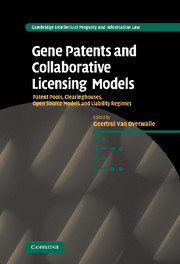 Gene Patents and Collaborative Licensing Models
Gene Patents and Collaborative Licensing Models from Part II - Clearinghouses
Published online by Cambridge University Press: 14 January 2010
Introduction
The notion of a royalty clearinghouse for biotech patents is beguilingly simple. So many problems would seem to be solved if there were a one-stop shop in which scientists could determine whether their activities were liable to infringe some particular gene patent, to determine whether any relevant genetic invention could be licensed, to pay for its use and to proceed on their voyage of scientific discovery.
Van Zimmeren's fascinating paper makes it clear, however, that it may be a long time before the dream of such a one-stop shop becomes a reality. She calls it ‘too big a leap forward’. I would go even further and suggest that there is much about the idea of a one-stop shop that is not only unachievable, but also potentially undesirable, unless appropriate standards of genetic patentability are firmly in place. Real thought must be given to whether the potential problem of the anticommons is not, after all, that too many genetic patents are granted and too few defences to infringement and compulsory licences available. If it is, then clearinghouses may even exacerbate, rather then relieve, the problem. Moreover, the analogy of a patent clearinghouse and a copyright collecting society seems to me to be a false one.
In her paper, van Zimmeren considers the advantages of the various clearinghouse mechanisms, and in particular the royalty collecting clearinghouse, in terms of their ability to meet three types of problem.
To save this book to your Kindle, first ensure [email protected] is added to your Approved Personal Document E-mail List under your Personal Document Settings on the Manage Your Content and Devices page of your Amazon account. Then enter the ‘name’ part of your Kindle email address below. Find out more about saving to your Kindle.
Note you can select to save to either the @free.kindle.com or @kindle.com variations. ‘@free.kindle.com’ emails are free but can only be saved to your device when it is connected to wi-fi. ‘@kindle.com’ emails can be delivered even when you are not connected to wi-fi, but note that service fees apply.
Find out more about the Kindle Personal Document Service.
To save content items to your account, please confirm that you agree to abide by our usage policies. If this is the first time you use this feature, you will be asked to authorise Cambridge Core to connect with your account. Find out more about saving content to Dropbox.
To save content items to your account, please confirm that you agree to abide by our usage policies. If this is the first time you use this feature, you will be asked to authorise Cambridge Core to connect with your account. Find out more about saving content to Google Drive.